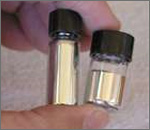Mercury, also called quicksilver, is a chemical element with the symbol Hg (Latinized Greek: hydrargyrum, meaning watery or liquid silver) and atomic number 80. A heavy, silve

ry d-block metal, mercury is one of six chemical elements that are liquid at or near room temperature and pressure, the others being caesium, francium, gallium, bromine, and rubidium. Mercury is the onlymetal that is liquid at standard conditions for temperature and pressure. With a melting point of 38.83°C and boiling point of 356.73°C, mercury has one of the narrowest ranges of its liquid state of any metal.
Mercury occurs in deposits throughout the world mostly as cinnabar (mercuric sulfide), which is the source of the red pigment vermilion, and is mostly obtained by reduction from cinnabar. Cinnabar is highly toxic by ingestion or inhalation of the dust. Mercury poisoning can also result from exposure to soluble forms of mercury (such as mercuric chloride or methylmercury), inhalation of mercury vapor, or eating fish contaminated with mercury.
Mercury is used in thermometers, barometers, manometers, sphygmomanometers, float valves, and other scientific apparatus, though concerns about the element's toxicity have led to mercury thermometers and sphygmomanometers being largely phased out in clinical environments in favor of alcohol-filled, digital, or thermistor-based instruments. It remains in use in a number of other ways in scientific and scientific research applications, and in amalgam material for dental restoration. It is used in lighting; electricity passed through mercury vapor in a phosphor tube produces short-wave ultraviolet light which then causes the phosphor to fluoresce, making visible light.
A pound coin (density ~7.6 g/cm3) floats in mercury due to the combination of the buoyant force and surface tension.
Mercury is a heavy, silvery-white metal. As compared to other metals, it is a poor conductor of heat, but a fair conductor of electricity. Mercury has an exceptionally low melting temperature for a d-block metal. A complete explanation of this fact requires a deep excursion into quantum physics, but it can be summarized as follows: mercury has a unique electronic configuration where electrons fill up all the available 1s, 2s, 2p, 3s, 3p, 3d, 4s, 4p, 4d, 4f, 5s, 5p, 5d and 6s subshells.

As such configuration strongly resists removal of an electron, mercury behaves similarly to noble gas elements, which form weakly bonded and thus easily melting solids. The stability of the 6s shell is due to the presence of a filled 4f shell. An f shell poorly screens the nuclear charge that increases the attractive Coulomb interaction of the 6s shell and the nucleus (see lanthanide contraction).
The absence of a filled inner f shell is the reason for the much higher melting temperature of cadmium. Metals such as gold have atoms with one less 6s electron than mercury. Those electrons are more easily removed and are shared between the gold atoms forming relatively strong metallic bonds. At the melting point (-38.86 °C) its density is 14.1 g/cm3.


